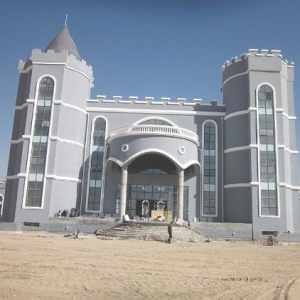In what has to be one of the most novel ways of promoting a wine region, the Ningxia Wine Challenge has also provided the local province with an abundance of international knowledge.
The Ningxia Wine Challenge was first promoted last year, as it advertised for 10 international winemakers to come to the Chinese northwestern wine region, to take part in the 2012 vintage. The two-year contest would see each of the successful winemakers select grapes and make firstly a red wine, then a year later return to make a white wine. Each winemaker would also be given the opportunity of returning to Ningxia up to three times to oversee the wine’s development. All expenses would be paid, but there was an even greater incentive. Each of the red and white wines would be judged by an independent panel in 2014, with the winner of each category taking home US$31,000. Some incentive you would agree.
Ningxia, which is one of China’s six major wine producing regions, has already gained a reputation for stunning reds. To the extent that in a blind tasting in 2011, where judges compared five Bordeaux and five Ningxia wines within a similar price bracket, four Ningxia wines were selected in the top five. (The judging panel consisted of five French and five Chinese.)
This winemaking competition however, was seen as a novel way of bringing the quality of the region’s wines to the attention of the media through the successful applicants talking about their experiences. Initially the competition was advertised in late July. By early September, 10 winemakers had been chosen, and were prepared to head away in time for vintage 2012. However, two had visa issues and one had a family matter that meant they couldn’t take part, leaving just seven winemakers, two of whom came from New Zealand - Dave Tyney and Patricia Miranda, from Marlborough. Both admit they were intrigued by the competition and the opportunity to experience Chinese wine production at the ground level. Tyney has links to the country, as his parents have lived in Shanghai and Beijing for the past few years. For Miranda, though, it was her first experience of the vast country.
Ningxia as a province is in the bottom five, when it comes to GDP in China due to its predominant agricultural base. However of the six main wine regions within the country, Ningxia is flagged as producing the highest quality red wines. It is also on track to expand on an exponential level.
Tyney said to say they were treated as royalty, is putting it mildly. There were three banquet meals a day, (starting with breakfast), vineyard and winery visits, and always lots of Ningxia wine. That went on for two weeks, before the winemakers even had the chance to start the real work.
“We were based in the city of Yinchuan, (population 4 million),” Tyney said. “Everyday we would visit a different vineyard in the morning, then the owners of the winery would take us out to a banquet lunch, where we would get through about two dozen red wine. Then we would shoot out and look at the winery and do further wine tastings. We had to do that for two weeks and by that stage we were ready to start work.”
Miranda said while that two-week period was very much a learning experience, it was also a time of exchanging ideas within the vineyards and wineries they were visiting. While money and resources don’t appear to be a problem, the lack of experience in some cases, particularly in terms of viticulture, stood out.
“The wineries look fantastic, they are impressive buildings with the best equipment. They are often massive in terms of how much they can produce, but there is no correlation between current production and the wineries capacity. They are building for what they will produce in the future, although there seems to be a need for more focus on how to make the winery more efficient in all areas.”
In terms of viticulture, Ningxia couldn’t be more different to New Zealand. Trellising in particular. Given the extremes of temperature, the vines are pruned straight after vintage, so they can be buried prior to the winter snows arriving. Which means the vines don’t have significant trunks, instead growing unconventionally and can look like an uncontrolled tree. Which in itself leads to issues during the hot humid summer months. (See next story on why China is unlikely to threaten world production.) Added to that the majority of locals don’t actually own the land, and most are former farmers of other agricultural products, turning their hand to viticulture on advise from the government. There appears to be a lack of ownership of the vineyards, creating a dearth of viticultural understanding.
“The wineries need to increase communication with the growers,” Tyney said. “The majority of growers focus on producing grapes that look good, (like table grapes) rather than focusing on yield/vine balance and flavour of fruit.”
So how did both winemakers find the 2012 vintage? Like many around the world, it wasn’t the best apparently. Disease due to the conditions during vintage was rampant.
“Yields were down and disease was up, and that all stems back to good vineyard practises,” according to Tyney. “You couldn’t pick when you wanted to, you had to pick before disease set in. Having said that, there were vineyards that didn’t have much disease, where they could get the fruit ripe and the fruit quality there was quite good.”
All the competition winemakers were given a parcel of Cabernet Sauvignon, all coming from the same vineyard. They then had the facilities of a brand new winery to produce their wine in.
Those wines are now resting in barrels, and each winemaker will be able to make up to two trips to oversee any further development. In September they will all head back for vintage 2013, where their task will be to produce a Chardonnay, under similar conditions. Same fruit, from same vineyard, made in the same winery. The final trip back to Ningxia will occur early next year, when the wines will be bottled and judged.
Although both Miranda and Tyney say it is unlikely to be their last trip back to the region overall. Both have been entranced by their experiences and would like to think they could be of use in any future development of the Ningxia wine region.
“For me, to be involved with people so interested in learning and growing in the wine industry was an amazing experience,” Miranda said. “They want to be the best in China so it is fantastic to be a part of that.” ν
This email address is being protected from spambots. You need JavaScript enabled to view it.












